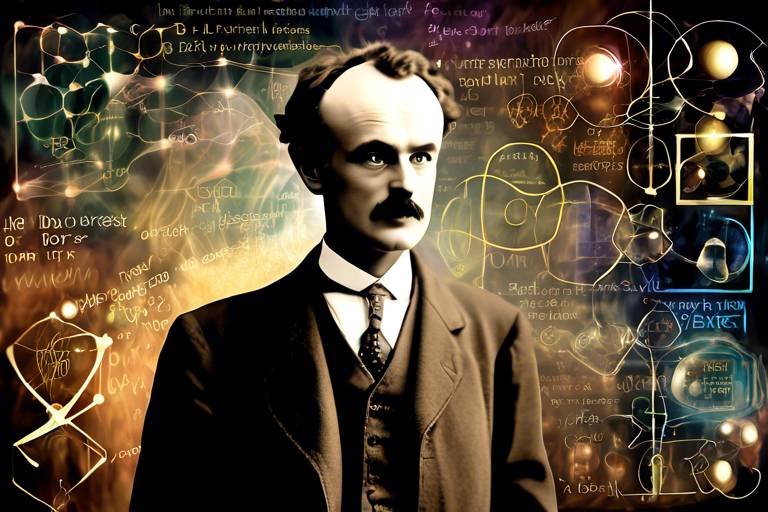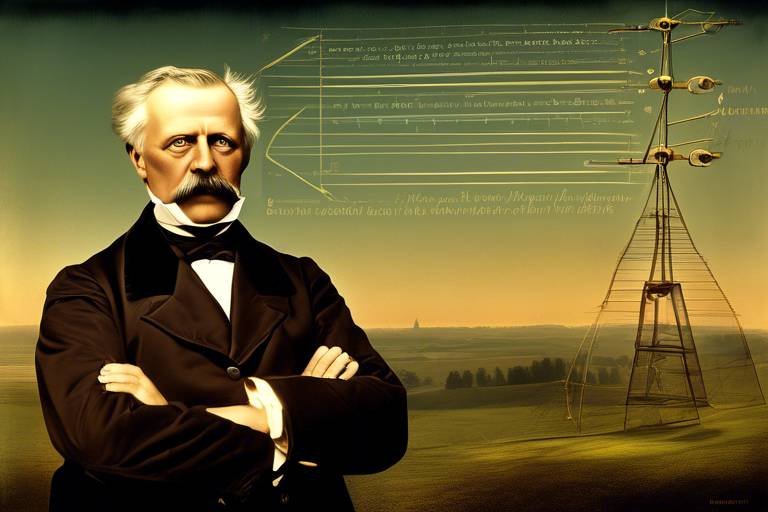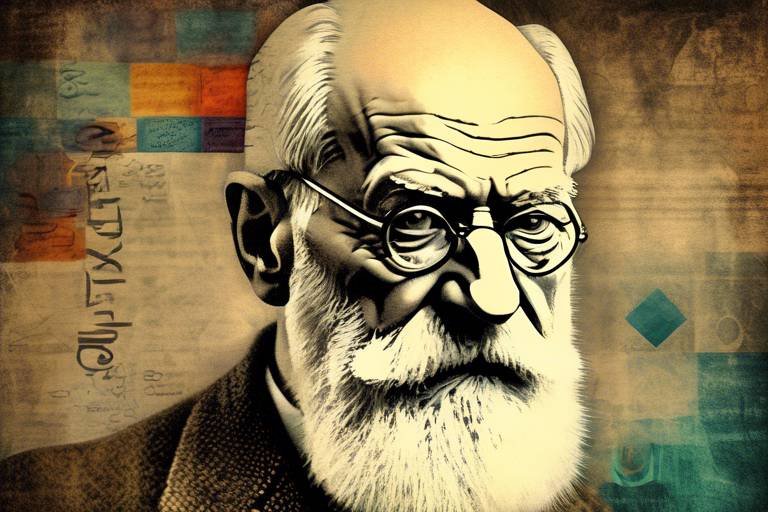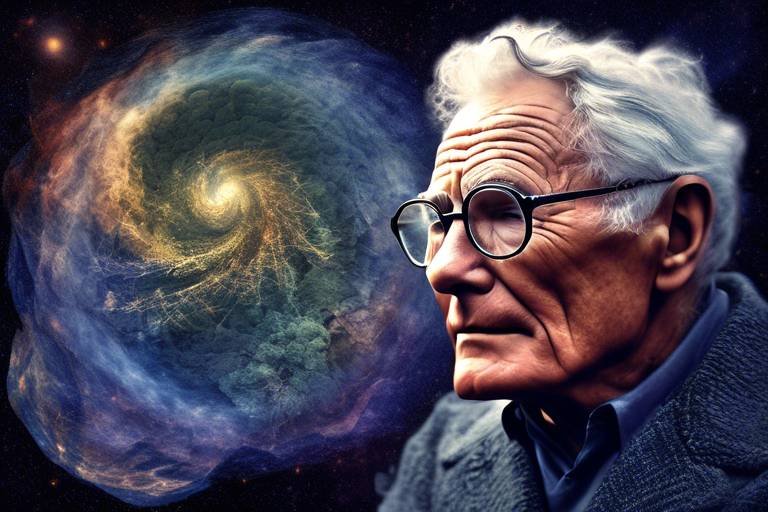The Discoveries of Paul Dirac in Quantum Mechanics
When we think about the world of quantum mechanics, one name that inevitably pops up is Paul Dirac. His work has not just shaped the field; it has fundamentally changed our understanding of the universe itself. Imagine a world where particles can exist in states that defy our classical intuitions. Dirac's groundbreaking contributions, particularly the formulation of the Dirac equation, have paved the way for a new era in physics, merging the realms of quantum mechanics and special relativity in a way that was previously thought impossible.
Dirac's insights extend beyond just equations and theories; they delve into the very nature of reality, including the existence of antimatter. His predictions about particles that mirror the properties of known particles but with opposite charges have opened a Pandora's box of questions about the universe. Why does antimatter exist? What does it mean for the fabric of our cosmos? These questions linger in the minds of physicists today, as they unravel the mysteries Dirac helped to expose.
In this article, we will explore the various dimensions of Dirac's contributions, from the Dirac equation itself to the astonishing prediction of antimatter. We will also delve into the experimental verification of these theories and how they have influenced the field of particle physics. So, buckle up, because the journey through Dirac's discoveries is not just a stroll through history; it's an exhilarating ride through the very fabric of reality!
The Dirac equation is often heralded as one of the cornerstones of modern physics. It describes the behavior of fermions, particles that follow the Pauli exclusion principle, which states that no two identical fermions can occupy the same quantum state simultaneously. This equation is remarkable because it successfully merges the principles of quantum mechanics with special relativity, giving rise to a new understanding of how particles behave at high velocities.
But what makes the Dirac equation so special? For starters, it introduces the concept of spin into quantum mechanics, a property that was not adequately explained by previous models. Spin is an intrinsic form of angular momentum carried by elementary particles, and it plays a crucial role in determining how particles interact with one another. The Dirac equation elegantly accounts for this, allowing physicists to predict the behavior of particles in a way that was previously unimaginable.
Dirac's prediction of antimatter is perhaps one of his most revolutionary contributions. Before Dirac, the idea of particles existing in a form that was opposite to our familiar matter seemed like science fiction. However, Dirac's theoretical framework suggested that for every particle, there should exist a corresponding antiparticle. This was not just a wild guess; it was a logical conclusion derived from his equation. The implications were staggering. If antimatter exists, what does that mean for our understanding of the universe?
The discovery of the positron, the antiparticle of the electron, was a monumental confirmation of Dirac's theories. In 1932, physicist Carl Anderson stumbled upon the positron while studying cosmic rays. This finding was like finding a missing piece of a puzzle that had long eluded scientists. The existence of the positron not only validated Dirac's predictions but also opened up new avenues of research in particle physics.
The experimental verification of the positron's existence marked a significant milestone in physics. Anderson's experiments involved using a cloud chamber to visualize the tracks of charged particles. When he observed a particle moving in the opposite direction to that of electrons, he realized he had discovered something extraordinary. This was the first evidence of antimatter, and it confirmed Dirac's theoretical predictions.
Dirac's work on antimatter has had lasting effects on particle physics. The concept of antimatter has influenced countless research projects and has led to the development of technologies such as positron emission tomography (PET) scans, which are widely used in medical imaging. Understanding antimatter also raises profound questions about the asymmetry between matter and antimatter in our universe. Why is there so much more matter than antimatter? This mystery continues to challenge physicists today.
Dirac didn't stop at just formulating the Dirac equation; he laid the groundwork for quantum field theory (QFT). His insights into particle interactions have shaped the way we understand forces in nature. QFT combines quantum mechanics with special relativity, allowing for a more comprehensive understanding of how particles interact at the most fundamental level.
Dirac's contributions extended to quantum statistical mechanics, where he formulated principles that govern the behavior of particles at quantum levels. His work on the statistical behavior of particles has provided the foundation for understanding systems of indistinguishable particles, which is crucial for fields like condensed matter physics.
The Fermi-Dirac statistics describe the distribution of indistinguishable particles, specifically fermions. This statistical approach is instrumental in understanding systems where particles obey the Pauli exclusion principle. It has far-reaching implications in various fields, including solid-state physics and astrophysics, where the behavior of electrons in metals and the properties of neutron stars are analyzed.
Dirac's theories have far-reaching applications in modern physics. From condensed matter physics to cosmology, his discoveries continue to influence ongoing research and technological advancements. The implications of his work are not just confined to theoretical physics; they manifest in practical applications that affect our daily lives, from medical imaging to the development of new materials.
- What is the Dirac equation?
The Dirac equation is a fundamental equation in quantum mechanics that describes the behavior of fermions, combining quantum mechanics with special relativity. - What is antimatter?
Antimatter is a type of matter that consists of antiparticles, which have the same mass as particles of ordinary matter but opposite charges. - Why is the discovery of the positron important?
The discovery of the positron confirmed Dirac's theories about antimatter and opened new avenues for research in particle physics. - How has Dirac's work influenced modern physics?
Dirac's work laid the foundation for quantum field theory and has applications in various fields, including condensed matter physics and cosmology.

The Dirac Equation
The Dirac equation stands as one of the most pivotal achievements in the realm of quantum mechanics. Formulated by the brilliant physicist Paul Dirac in 1928, this equation not only describes the behavior of fermions—particles like electrons that follow the rules of quantum mechanics—but also elegantly combines the principles of quantum mechanics with special relativity. Imagine trying to dance the tango while simultaneously doing the cha-cha; it's a complex endeavor, yet Dirac managed to synchronize these two seemingly disparate realms of physics.
At its core, the Dirac equation is a wave equation that predicts the existence of particles with spin-½, which are fundamental to the structure of matter. It can be expressed mathematically as:
(iħγ^μ∂_μ - mc)ψ 0
Here, ħ represents the reduced Planck's constant, γ^μ are the gamma matrices, ∂_μ denotes the four-gradient operator, m is the mass of the particle, and ψ is the wave function of the particle. This equation is not just a collection of symbols; it encapsulates a profound truth about the universe. It implies that particles can exist in multiple states simultaneously, a concept that challenges our everyday understanding of reality.
One of the most astonishing implications of the Dirac equation is its prediction of antimatter. When Dirac solved the equation, he encountered solutions that suggested the existence of particles with the same mass as electrons but with opposite charge. This was a groundbreaking moment, as it hinted at a mirror universe where every particle has a corresponding antiparticle. Can you imagine a world where everything has a twin that behaves oppositely? That's the essence of antimatter!
The Dirac equation has also paved the way for numerous advancements in physics, leading to the development of quantum field theory. This theory describes how particles interact and has become a cornerstone of modern physics, influencing everything from particle accelerators to our understanding of the universe's fundamental forces.
In summary, the Dirac equation is not merely an abstract mathematical construct; it is a vital framework that has reshaped our understanding of the quantum world. Its profound implications continue to resonate throughout the fields of physics and beyond, reminding us that the universe is much more intricate and fascinating than we often perceive.
- What is the significance of the Dirac equation? The Dirac equation is significant because it unifies quantum mechanics and special relativity, leading to the prediction of antimatter and the development of quantum field theory.
- How did Dirac's equation predict antimatter? The solutions to the Dirac equation included negative energy states, which suggested the existence of particles with opposite charge, leading to the concept of antimatter.
- What are fermions? Fermions are particles that follow the Pauli exclusion principle, meaning no two fermions can occupy the same quantum state simultaneously. Examples include electrons, protons, and neutrons.

Antimatter and Its Implications
When we think about the universe, we often picture stars, planets, and the vastness of space. But what if I told you there's a whole other side to it—one that exists in the form of antimatter? Paul Dirac was the genius who ventured into this mysterious territory, and his predictions have completely transformed our understanding of physics. Antimatter is essentially the mirror image of ordinary matter, with particles that have the same mass but opposite charge. Imagine a world where every particle has a twin that behaves in the exact opposite way. Sounds like science fiction, right? Well, thanks to Dirac, it’s a reality!
Dirac's groundbreaking work led to the prediction of antimatter, specifically the positron, which is the antimatter counterpart of the electron. This prediction was not just an academic exercise; it had profound implications for both particle physics and cosmology. By suggesting that antimatter exists, Dirac opened up a Pandora’s box of questions about the universe's composition and the fundamental laws governing it. For instance, if antimatter exists, why is the observable universe predominantly composed of matter? This question has puzzled scientists for decades, leading to various theories and research avenues.
Furthermore, the implications of antimatter stretch far beyond theoretical physics. The concept has practical applications too. For example, antimatter is used in Positron Emission Tomography (PET) scans, a revolutionary medical imaging technique that helps doctors diagnose diseases like cancer. In a PET scan, a small amount of radioactive material is introduced into the body, which emits positrons as it decays. When these positrons encounter electrons in the body, they annihilate each other, producing gamma rays that are detected to create detailed images of the body's internal structures. This is just one example of how Dirac's theories have led to real-world applications that save lives.
Moreover, the existence of antimatter raises intriguing questions about the fate of the universe. If we could harness antimatter as a power source, it could potentially revolutionize energy production. The energy released from matter-antimatter annihilation is immense—far greater than any chemical reaction we currently use. However, the challenge lies in producing and storing antimatter, as it is incredibly rare and costly to create. Theoretical physicists are continuously exploring ways to make this a reality, and Dirac's foundational work remains central to these discussions.
In summary, Dirac's prediction of antimatter has not only reshaped our understanding of the universe but also provided us with tools and concepts that have practical applications in medicine and energy. The journey into the world of antimatter is just beginning, and as we continue to explore its mysteries, we may uncover even more secrets about the universe and our place within it.
- What is antimatter? Antimatter is a type of matter that is composed of antiparticles, which have the same mass as particles of ordinary matter but opposite charges.
- How was antimatter discovered? Antimatter was first predicted by Paul Dirac in 1928 and was later confirmed with the discovery of the positron in 1932 by Carl Anderson.
- What are the applications of antimatter? Antimatter has applications in medical imaging (like PET scans) and has potential uses in energy production.
- Why is there more matter than antimatter in the universe? This is a significant question in cosmology, and researchers are investigating various theories to explain this imbalance.

The Birth of the Positron
Imagine a world where every particle has a counterpart, a twin that behaves in ways we can scarcely comprehend. This was the revolutionary idea proposed by Paul Dirac when he predicted the existence of antimatter. Specifically, he foresaw the positron, the electron's antiparticle, which would eventually be discovered in 1932 by Carl Anderson. This monumental finding not only confirmed Dirac's theories but also opened a new chapter in our understanding of the universe.
Dirac's formulation of the Dirac equation was the key that unlocked this door. It elegantly combined principles of quantum mechanics with special relativity, leading to the prediction of particles that had yet to be observed. The positron, with its positive charge, was the first of these elusive antimatter particles. It was a moment that sent ripples through the scientific community, much like the first time we realized that the Earth revolved around the Sun rather than the other way around.
But how did scientists confirm the existence of the positron? The journey began with Anderson's experiments using a cloud chamber, a device that allowed physicists to visualize the paths of charged particles. When cosmic rays collided with atoms in the chamber, they produced various particles, including positrons. The trails left behind were unmistakable; they curved in the opposite direction of electrons due to their positive charge. This experimental evidence was a resounding affirmation of Dirac's predictions, and it marked a pivotal moment in the field of particle physics.
The implications of discovering the positron were profound. It suggested that the universe was not just composed of ordinary matter but also of antimatter, a concept that was previously relegated to the realm of science fiction. This revelation led to further explorations into the nature of the universe, including the question: Where is all the antimatter? Despite its theoretical significance, antimatter appeared to be exceedingly rare in our observable universe, raising intriguing questions about the very fabric of reality.
As we delve deeper into the world of particle physics, we find that the positron is not just a curiosity but a fundamental component of our understanding of the universe. The birth of the positron has paved the way for numerous advancements, including applications in medical imaging techniques like positron emission tomography (PET). This technology utilizes the annihilation of positrons and electrons to create detailed images of metabolic processes in the body, showcasing how Dirac's theories have transcended the realm of theoretical physics into practical, life-saving applications.
In summary, the birth of the positron was not merely an academic achievement; it was a moment that reshaped our comprehension of the universe. Dirac's predictions have laid the groundwork for a myriad of scientific inquiries, each revealing more about the intricate dance between matter and antimatter. As we continue to explore these realms, we are reminded of the power of human curiosity and the profound impact of theoretical physics on our understanding of reality.
- What is a positron? A positron is the antiparticle of the electron, possessing the same mass as an electron but with a positive charge.
- Who discovered the positron? The positron was discovered by physicist Carl Anderson in 1932 during his experiments with cosmic rays.
- What is the significance of the positron in physics? The discovery of the positron confirmed Dirac's theories on antimatter and has led to significant advancements in both theoretical and applied physics.
- How does positron emission tomography (PET) work? PET scans utilize the annihilation of positrons and electrons to produce images of metabolic processes in the body, aiding in medical diagnoses.

Experimental Verification
The journey to confirm the existence of the positron, a particle that Paul Dirac had predicted, was nothing short of a scientific adventure filled with anticipation and excitement. In the early 1930s, physicists were on the lookout for evidence of this elusive anti-electron, which Dirac's equations suggested should exist. The breakthrough came in 1932 when Carl Anderson, an American physicist, conducted a series of experiments using a cloud chamber, a device that allows for the visualization of charged particles as they pass through a supersaturated vapor.
Anderson's cloud chamber experiments revealed a striking pattern: when cosmic rays collided with atoms in the chamber, they produced tracks that indicated the presence of a particle with the same mass as an electron but with a positive charge. This was a pivotal moment in physics, as it provided the first experimental verification of Dirac's theory. The discovery was so significant that it led to a flurry of research aimed at understanding the implications of antimatter in the broader context of particle physics.
To further substantiate Dirac's predictions, a series of experiments were conducted, each building upon the last. These experiments not only confirmed the existence of the positron but also explored its properties. The following table summarizes some of the key experiments that contributed to the verification of the positron's existence:
| Experiment | Year | Key Findings |
|---|---|---|
| Cloud Chamber Experiment | 1932 | Observation of tracks indicating a positively charged particle |
| Positron Production in Nuclear Reactions | 1934 | Confirmation of positron emission during certain decay processes |
| Electron-Positron Annihilation | 1955 | Observation of gamma rays resulting from electron-positron annihilation |
These experiments not only validated Dirac's theoretical predictions but also opened up new avenues for research in particle physics. The discovery of the positron led to a deeper understanding of the nature of matter and antimatter, sparking discussions about the fundamental symmetries of the universe. Moreover, the concept of antimatter has profound implications for our understanding of cosmology and the evolution of the universe itself.
As we reflect on the experimental verification of the positron, it's essential to recognize the collaborative spirit of the scientific community. Physicists around the world were eager to test Dirac's bold predictions, and their collective efforts ultimately transformed the landscape of modern physics. The excitement surrounding these discoveries not only confirmed Dirac's theories but also inspired generations of scientists to explore the mysteries of the quantum world.
- What is the Dirac equation? The Dirac equation is a fundamental equation in quantum mechanics that describes the behavior of fermions, merging quantum mechanics with special relativity.
- What is antimatter? Antimatter is a type of matter composed of antiparticles, which have the same mass as particles of ordinary matter but opposite charges.
- Who discovered the positron? The positron was discovered by Carl Anderson in 1932 during experiments conducted in a cloud chamber.
- What are the implications of antimatter in physics? Antimatter has significant implications for our understanding of particle physics, cosmology, and the fundamental symmetries of the universe.

Impact on Particle Physics
Paul Dirac's groundbreaking work on antimatter has had profound implications for the field of particle physics. His theoretical predictions not only reshaped our understanding of the universe but also opened new avenues for research that continue to influence the scientific community today. The concept of antimatter, once a mere theoretical construct, has evolved into a cornerstone of modern physics, leading to revolutionary discoveries and technologies.
One of the most significant impacts of Dirac's work is the establishment of the framework for exploring fundamental particles and their interactions. Before Dirac, the idea of particles having corresponding antiparticles was largely speculative. However, Dirac's equations suggested that for every particle, there exists an antiparticle with the same mass but opposite charge. This foundational concept has become a critical element in the study of particle physics.
To illustrate the impact of Dirac's theories, consider the following key areas:
- Particle Accelerators: The existence of antimatter has led to the development of advanced particle accelerators, such as the Large Hadron Collider (LHC), which are designed to explore the properties of both matter and antimatter. These facilities have provided invaluable data, confirming many of Dirac's predictions.
- Quantum Chromodynamics (QCD): Dirac's insights paved the way for the development of QCD, the theory describing the strong interaction between quarks and gluons. This theory is essential for understanding the behavior of particles at high energies and densities.
- Cosmology: The implications of antimatter extend beyond particle physics into cosmology, where the asymmetry between matter and antimatter is a fundamental question. Understanding why our universe is predominantly composed of matter remains one of the biggest challenges in modern physics, and Dirac's work provides a framework for exploring this mystery.
Moreover, Dirac's contributions have also inspired numerous experimental efforts aimed at detecting and studying antimatter. The discovery of the positron was just the beginning; subsequent research has led to the identification of various antiparticles, including antiprotons and antihydrogen. These discoveries have not only validated Dirac's theories but also expanded our understanding of the universe's structure and composition.
In summary, the impact of Paul Dirac on particle physics is monumental. His pioneering ideas have not only confirmed the existence of antimatter but have also laid the groundwork for ongoing research in particle physics, cosmology, and beyond. As scientists continue to explore the mysteries of the universe, Dirac's legacy will undoubtedly remain a guiding light in their quest for knowledge.
Q1: What is the significance of the Dirac equation?
A1: The Dirac equation is significant because it merges quantum mechanics with special relativity, providing a comprehensive description of fermions and predicting the existence of antimatter.
Q2: How did Dirac's predictions lead to the discovery of the positron?
A2: Dirac predicted the existence of antiparticles, and the positron was discovered as the first confirmed antiparticle, validating his theoretical framework.
Q3: What are some applications of Dirac's theories in modern physics?
A3: Dirac's theories have applications in various fields, including particle physics, condensed matter physics, and cosmology, influencing research and technological advancements.

Dirac's Contribution to Quantum Field Theory
When we talk about the evolution of physics, one name that stands out is Paul Dirac. His contributions to quantum field theory have been nothing short of revolutionary. Imagine trying to understand the universe's tiniest particles and their interactions without the framework that Dirac provided. It would be like trying to navigate a maze blindfolded! Dirac's insights helped to illuminate the path through this complex terrain, merging the principles of quantum mechanics with the relativistic nature of space and time.
At the heart of Dirac's contribution is the realization that particles are not just isolated entities; they exist in a field that permeates all of space. This idea was groundbreaking. Before Dirac, physicists primarily viewed particles as discrete objects. However, Dirac proposed that these particles could be understood as excitations of underlying fields. This perspective paved the way for the development of quantum electrodynamics (QED) and the standard model of particle physics, which describes how particles interact through fundamental forces.
One of the major breakthroughs Dirac introduced was the concept of antiparticles. His equations suggested that for every particle, there exists a corresponding antiparticle with opposite properties. This was a radical idea at the time, but it opened up a new realm of possibilities in particle physics. The existence of antiparticles was later confirmed with the discovery of the positron, which not only validated Dirac's theories but also enriched our understanding of the universe. The implications of this discovery extend far beyond mere theoretical musings; they have practical applications in fields such as medical imaging and particle accelerators.
Dirac's work also led to the formulation of the Dirac field, which describes fermionic particles. This field is essential for understanding the behavior of particles like electrons and quarks, which obey the Pauli exclusion principle. The Dirac field has become a cornerstone of modern quantum field theory, allowing physicists to calculate interactions and predict outcomes in experiments with remarkable accuracy.
To illustrate the significance of Dirac's contributions, let's consider a few key aspects:
| Aspect | Significance |
|---|---|
| Antiparticles | Led to the discovery of positrons and expanded our understanding of particle interactions. |
| Dirac Field | Provided a framework for understanding fermionic particles and their interactions. |
| Quantum Electrodynamics (QED) | Formulated the interactions between light and matter, leading to precise predictions and experimental confirmations. |
Dirac's contributions have had a profound impact on our understanding of the universe. His ability to merge seemingly disparate concepts into a cohesive framework has inspired countless physicists and continues to shape the field today. As we delve deeper into the mysteries of the cosmos, we owe much of our progress to the pioneering work of Paul Dirac.

Quantum Statistical Mechanics
When we dive into the realm of , we're stepping into a fascinating world that combines the principles of quantum mechanics with statistical methods. This field is crucial for understanding how particles behave at the quantum level, particularly when they are indistinguishable from one another. Imagine a crowded room where everyone is dressed in identical outfits; it's tough to tell who is who! Similarly, in quantum mechanics, particles like electrons and protons can be so similar that their individual identities become irrelevant. This is where Dirac's contributions shine, providing us with the tools to navigate this complexity.
One of Dirac's most significant contributions is the formulation of the principles that govern the behavior of indistinguishable particles. He introduced the concept of Fermi-Dirac statistics, which applies to particles known as fermions. These particles, which include electrons, protons, and neutrons, obey the Pauli exclusion principle, meaning no two fermions can occupy the same quantum state simultaneously. This principle is akin to a game of musical chairs where, once a chair is taken, no one else can sit there. This unique behavior leads to fascinating phenomena, such as the stability of matter and the formation of complex structures in the universe.
To better understand the implications of Fermi-Dirac statistics, consider the following table that summarizes the key differences between Fermi-Dirac and Bose-Einstein statistics:
| Characteristic | Fermi-Dirac Statistics | Bose-Einstein Statistics |
|---|---|---|
| Type of Particles | Fermions (e.g., electrons) | Bosons (e.g., photons) |
| Pauli Exclusion Principle | Applies | Does not apply |
| Behavior at Low Temperatures | Form a Fermi sea | Can condense into a single quantum state |
Understanding these distinctions is crucial for delving deeper into how particles interact with one another in various states of matter, such as solids, liquids, and gases. For instance, in metals, the conduction of electricity is primarily due to the movement of electrons, which are fermions. The principles of Fermi-Dirac statistics help explain why metals can conduct electricity efficiently, while insulators cannot.
Furthermore, Dirac's work in quantum statistical mechanics has paved the way for numerous applications across different fields. For example, in condensed matter physics, his theories help us understand phenomena like superconductivity and magnetism. In cosmology, they contribute to our understanding of the early universe and the formation of stars and galaxies. The ripple effects of Dirac's insights are felt in various domains, demonstrating the interconnectedness of physics as a whole.
In conclusion, quantum statistical mechanics is not just a theoretical framework; it's a lens through which we can view the universe's intricate dance of particles. Thanks to Paul Dirac, we have a robust understanding of how these particles behave under the rules of quantum mechanics, allowing us to unravel the mysteries of the cosmos.
- What is quantum statistical mechanics? Quantum statistical mechanics is a branch of physics that applies statistical methods to quantum systems, helping us understand the behavior of indistinguishable particles.
- What are Fermi-Dirac statistics? Fermi-Dirac statistics describe the distribution of fermions, which are particles that obey the Pauli exclusion principle.
- How do Dirac's theories impact modern physics? Dirac's theories have far-reaching implications in various fields, including condensed matter physics, cosmology, and particle physics.

Fermi-Dirac Statistics
Fermi-Dirac statistics are a fascinating aspect of quantum mechanics that describe the distribution of indistinguishable particles known as fermions. Named after the physicists Enrico Fermi and Paul Dirac, these statistics are crucial for understanding systems where particles obey the Pauli exclusion principle, which states that no two fermions can occupy the same quantum state simultaneously. This principle is not just a quirky rule of the quantum world; it has profound implications for the behavior of matter at a fundamental level.
To grasp the significance of Fermi-Dirac statistics, consider the analogy of a crowded concert. Imagine a venue where every seat is filled, and no one can sit in the same spot as someone else. Just like concert-goers, fermions—such as electrons—are restricted in how they can occupy energy levels. This restriction leads to unique behaviors in systems like metals and semiconductors, where the arrangement of electrons determines the material's electrical properties.
One of the key outcomes of Fermi-Dirac statistics is the concept of the Fermi energy, which represents the highest energy level occupied by fermions at absolute zero temperature. Below this energy level, all states are filled, while above it, states are empty. This distribution of energy levels is essential for understanding phenomena such as electrical conductivity and heat capacity in materials. For instance, the behavior of electrons in a metal can be explained using these statistics, leading to insights into why some materials conduct electricity better than others.
To illustrate the differences between Fermi-Dirac statistics and other statistical distributions, such as Bose-Einstein statistics (which apply to bosons), we can refer to the following table:
| Characteristic | Fermi-Dirac Statistics | Bose-Einstein Statistics |
|---|---|---|
| Particle Type | Fermions (e.g., electrons, protons) | Bosons (e.g., photons, helium-4) |
| Pauli Exclusion Principle | Applies (no two fermions can occupy the same state) | Does not apply (multiple bosons can occupy the same state) |
| Example Systems | Electrons in metals, atomic nuclei | Photons in a laser, superfluid helium |
This table highlights the fundamental differences between these two statistical distributions, showcasing how they govern the behavior of different types of particles. The implications of Fermi-Dirac statistics extend far beyond theoretical physics; they have practical applications in various fields, including condensed matter physics, quantum computing, and even astrophysics, where they help explain the behavior of electrons in white dwarf stars.
In summary, Fermi-Dirac statistics provide a crucial framework for understanding the behavior of fermions in various physical systems. By recognizing how these particles interact and occupy energy states, researchers can gain valuable insights into the properties of materials and the fundamental workings of the universe. As we delve deeper into the quantum realm, the principles of Fermi-Dirac statistics will undoubtedly continue to play a vital role in shaping our understanding of the physical world.
- What are fermions? Fermions are particles that follow the Pauli exclusion principle, meaning that no two fermions can occupy the same quantum state at the same time. Examples include electrons, protons, and neutrons.
- How do Fermi-Dirac statistics differ from Bose-Einstein statistics? Fermi-Dirac statistics apply to fermions and incorporate the Pauli exclusion principle, while Bose-Einstein statistics apply to bosons, which can share quantum states.
- What is the Fermi energy? The Fermi energy is the highest energy level occupied by fermions at absolute zero temperature, and it plays a crucial role in determining the electrical and thermal properties of materials.

Applications in Modern Physics
Paul Dirac's groundbreaking theories have had a profound impact on modern physics, influencing a variety of fields and leading to significant advancements in our understanding of the universe. His work is not just a relic of the past; it is a vibrant part of ongoing research that continues to shape the scientific landscape. From the realms of condensed matter physics to the vastness of cosmology, Dirac's contributions are woven into the fabric of contemporary scientific inquiry.
One of the most notable applications of Dirac's theories is found in the study of quantum computing. The principles of quantum mechanics, particularly those that Dirac helped to elucidate, underpin the operation of quantum computers. These devices leverage the behavior of particles at the quantum level to perform calculations at speeds unimaginable with classical computers. Dirac's insights into the behavior of fermions, particles that follow Fermi-Dirac statistics, are crucial for understanding how qubits function, making his work foundational in this exciting field.
In condensed matter physics, Dirac's ideas have led to the exploration of exotic states of matter, such as topological insulators and superconductors. These materials exhibit unique properties that can be understood through the lens of quantum mechanics and quantum field theory, both of which were significantly advanced by Dirac's research. The theoretical framework he provided allows physicists to predict and manipulate the behavior of these materials, paving the way for technological innovations, including advanced electronic devices and energy-efficient technologies.
Furthermore, Dirac's work has profound implications for cosmology. His predictions regarding antimatter not only transformed particle physics but also influenced theories about the universe's composition. The existence of antimatter raises intriguing questions about the asymmetry between matter and antimatter in the universe, leading to ongoing research into the conditions that led to the observable universe we inhabit today. This exploration has significant implications for our understanding of the Big Bang and the evolution of cosmic structures.
To illustrate the diverse applications of Dirac's work, here’s a summary table:
| Field | Application | Significance |
|---|---|---|
| Quantum Computing | Qubit behavior and quantum algorithms | Enables faster computations and complex problem-solving |
| Condensed Matter Physics | Study of topological insulators and superconductors | Leads to advancements in materials science and electronics |
| Cosmology | Understanding matter-antimatter asymmetry | Informs theories about the universe's origin and evolution |
In conclusion, the applications of Paul Dirac's theories are as multifaceted as they are profound. His legacy continues to inspire new generations of physicists, who build upon his foundational work to unlock the mysteries of the universe. As we delve deeper into the quantum realm, Dirac's contributions remind us of the beauty and complexity of the world around us, challenging us to think beyond the conventional and explore the unknown.
- What is the Dirac equation?
The Dirac equation is a fundamental equation in quantum mechanics that describes the behavior of fermions, merging quantum mechanics with special relativity.
- How did Dirac predict antimatter?
Dirac's theoretical work suggested the existence of particles with negative energy solutions, leading to the prediction of antimatter, specifically the positron.
- What impact did Dirac have on modern physics?
Dirac's contributions laid the groundwork for quantum field theory and have influenced various fields, including quantum computing, condensed matter physics, and cosmology.
Frequently Asked Questions
- What is the Dirac equation?
The Dirac equation is a fundamental equation in quantum mechanics that describes the behavior of fermions. It beautifully combines quantum mechanics with special relativity, offering critical insights into the world of particle physics. Think of it as a bridge connecting the two realms, allowing us to understand particles like electrons in a more comprehensive way.
- How did Paul Dirac predict antimatter?
Dirac's prediction of antimatter stemmed from his work on the Dirac equation. He discovered that for every particle, there should be a corresponding antiparticle with opposite charge. This revolutionary idea led to the discovery of the positron, the electron's antiparticle, confirming his theories and opening new doors in the field of particle physics.
- What is the significance of the positron?
The positron is significant because it was the first antiparticle discovered, validating Dirac's predictions about antimatter. Its discovery not only confirmed theoretical physics but also paved the way for further research in particle physics and cosmology, reshaping our understanding of the universe.
- How did Dirac's work impact particle physics?
Dirac's contributions to our understanding of antimatter have had lasting effects on particle physics. His theories have influenced research on fundamental particles, leading to advancements in technologies like particle accelerators and even applications in medical imaging, such as PET scans.
- What is quantum field theory, and how did Dirac contribute to it?
Quantum field theory is a framework that combines classical field theory, quantum mechanics, and special relativity. Dirac's insights laid the groundwork for this theory, allowing physicists to describe how particles interact through fields. His work has been crucial in the development of the Standard Model of particle physics.
- What are Fermi-Dirac statistics?
Fermi-Dirac statistics describe the distribution of indistinguishable particles known as fermions, which include electrons. These statistics are essential for understanding systems where particles obey the Pauli exclusion principle, influencing fields like condensed matter physics and quantum computing.
- How are Dirac's theories applied in modern physics?
Dirac's theories continue to have far-reaching applications in modern physics, influencing areas such as condensed matter physics, cosmology, and even high-energy particle physics. His work helps scientists explore the fundamental nature of the universe and develop new technologies that impact our daily lives.



















